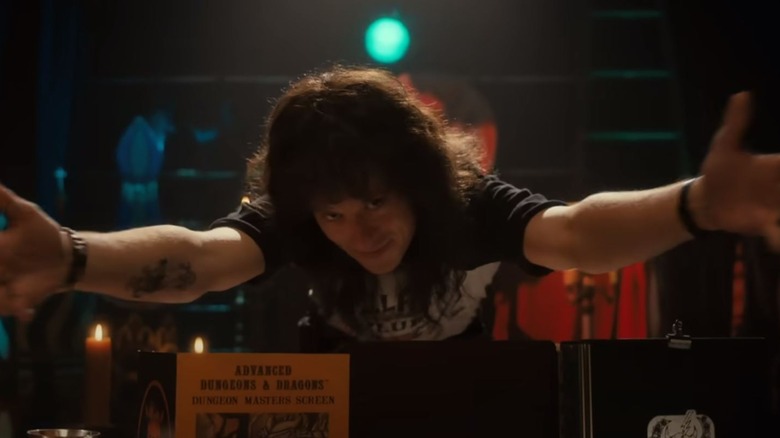Stranger Things 4's Satanic Panic Reference Explained
Contains spoilers for "Stranger Things 4" Part 1
"Stranger Things 4" Part 1 is a bad time for every character whose name isn't Vecna, and new "Stranger Things" character Jason Carver (Mason Dye) is no exception. The talented and charming captain of the Hawkins High School baseball team seems to have his life together, and as he gets in his head that "Dungeons & Dragons"-loving metalhead Eddie Munson (Joseph Quinn) is responsible for the mysterious murders that plague the town, he does what any clean-cut and popular jock in a 1980s movie would, and decides to track and capture the "freak" Eddie with his friends.
Sadly for Jason, he doesn't quite manage to catch Eddie before they both witness one of Vecna's grisly, physics-defying supernatural murders. This shakes Jason to his very core, and his quest to bring down Eddie now has a brand new tint. During an impassioned speech in a town meeting in Episode 6, Jason manages to convince the townspeople that Eddie and his "Dungeons & Dragons" group — which is conveniently named the Hellfire Club — are in league with the Biblical devil itself, and using unholy powers to sacrifice innocent townspeople for wicked reasons.
Granted, Jason seems to be genuinely religious, and two people very close to him have already been turned into levitating human pretzels in Eddie's presence, so he's not entirely wrong about supernatural forces being at play — he's just barking up a wrong tree. However, the panic he's causing is actually a far more real historical phenomenon than many viewers may realize.
People really used to think Dungeons & Dragons is the devil's plaything
What Jason does in "Stranger Things 4" is actually just a dramatized small-scale reference to what the BBC calls the "Dungeons & Dragons" panic. The classic role-playing game has been around since 1974, but it took a good while for people to start seeing it as a harmless hobby for fantasy enthusiasts. Starting from 1979, multiple complex and tragic disappearences and even deaths of young people were blamed on the game, despite the fact that it had nothing to do with anything.
There were failed lawsuits, and ni 1983, the woman who lost them formed the rather suspiciously named BADD — or Bothered About Dungeons and Dragons, if you will — and proceeded to drag the game's name through every imaginable kind of mud, associating it with witchcraft and every imaginable evil deed. BADD and D&D-themed moral panics were still very much around in the mid-1980s and much, much beyond.
The "Dungeons & Dragons" panic, unfortunately, was just one offshoot of the crazy real-life story of the Satanic Panic in the 1980s. For many long years, anything from song lyrics to suspicious behavior could be interpreted as being in cahoots with hellish forces, and the establishment pretty much just encouraged the cultural phenomenon and rolled with it — right down to President Ronald Reagan himself, who used a whole bunch of "good against evil" terminology in his famous "Evil Empire" speech of 1983.
Knowing all this, poor Eddie Munson is a prime example of a victim of the historical Satanic Panic within the show's context — and by the look of things, the rest of the Hellfire Club members won't have it any easier once "Stranger Things 4" Part 2 arrives.

